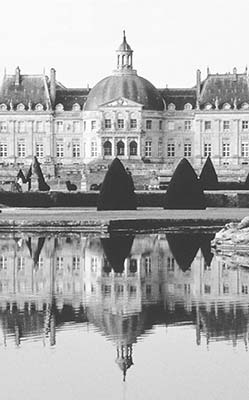
Château de Vaux-le-Vicomte • Fontainbleu • Chantilly
ORIENTATION TO VAUX-LE-VICOMTE
The region around Paris (Ile de France) is studded with sumptuous palaces. The city’s booming elite class made it the heartland of European château-building in the 16th and 17th centuries. Most of these châteaux were lavish hunting lodges—getaways from the big city. The only things they defended were aristocratic egos.
If you’re planning to visit just one palace in all of Europe, it should be Versailles (see previous chapter). But unlike heavily touristed Versailles, the three châteaux recommended here are quiet (at least on weekdays), letting you enjoy their original pastoral ambience. Consider visiting at least one; they are each very different.
For sheer beauty and intimacy (open daily, weekends only Nov-mid-March); see here.
For its history, fine interior, and pleasant city (château closed Tue, covered by Paris Museum Pass); see here.
For its beautiful setting and fine collection of paintings (closed Tue, covered by Paris Museum Pass); see here.
Mobilis Ticket: Day-trippers using the train to reach Vaux-le-Vicomte or Fontainebleau should purchase a regional Mobilis ticket, which covers a day of travel in the greater Paris region (€16.60, buy at any Métro station, all-day ticket covers zones 1-5). The ticket covers your Métro rides to and from the train station and round-trip train fare (for Fontainebleau, it also includes the bus to and from the château), saving you about €9 total. When you buy the ticket, fill in your name and the date, and then use it like a Métro ticket, validating it on the day you travel in the small gray machines on the train platforms.
Versailles may be most travelers’ first choice for its sheer historic importance, but Vaux-le-Vicomte (voh luh vee-komt) is just flat-out ravishing. With a harmony of architecture, interior decor, and garden design that you won’t find anywhere else, it gets my vote for one of the most beautiful châteaux in all of France.
Compared with Versailles, it’s also more intimate, better furnished, and comes with a fraction of the crowds. Though getting to Vaux-le-Vicomte requires more effort, it’s an absolute joy to tour. Located in a huge forest, with magnificent gardens and no urban sprawl in sight, Vaux-le-Vicomte gives me more than a twinge of palace envy.
By Train: Ideally, leave Paris from Gare de l’Est before 12:00, traveling to Verneuil-l’Etang (direction: Provins). Buying a Mobilis ticket (see earlier) saves you time and money. Otherwise, buy a round-trip ticket at the white ticket machines between tracks 15-19 or at the SNCF ticket booth opposite track 17. Ile de France (suburban) trains depart from tracks 13-22 (€16.60 round-trip, daily at :46 past the hour, 35 minutes; return trains depart Verneuil-l’Etang’s track 2 at :32 past the hour).
Outside the station at Verneuil-l’Etang, a Châteaubus shuttle, timed to train arrivals, takes you to Vaux-le-Vicomte (€5 one-way, cash only, pay driver, daily April-early Nov plus Sat evenings May-Sept). Return shuttles leave the château at 12:05, 13:05, 15:05, and 18:05, with additional Saturday departures at 16:05, 19:05, and 22:05. A 23:05 shuttle (€25) takes you all the way back to Paris’s Gare de Lyon.
You can also take the RER-D train to Melun from Gare de Lyon, Gare du Nord, or Châtelet-Les Halles (direction: Montereau, 3/hour, 50 minutes). Faster SNCF Banlieue trains to Melun leave from Gare de Lyon (2/hour, 30 minutes, about €9 one-way). The last return train from Melun to Paris departs at about 23:45.
From Melun’s scruffy train station, taxis make the 15-minute drive to Vaux-le-Vicomte (€20 one-way Mon-Sat, €26 evenings and Sun, taxi tel. 01 64 52 51 50). Ask a staffer at the château to call a cab for your return, or schedule a pickup time with your driver. Seek others with whom you can split the fare.
By Excursion Bus: The City Vision tour company offers a handy excursion bus to Vaux-le-Vicomte and Fontainebleau (about €70, includes châteaux entry; departs at 9:15 and returns at 18:15; runs April-Oct Mon, Wed-Sat, and first Sun of the month; tel. 01 42 60 30 01, www.pariscityvision.com; also offers private minibus excursions).
By Car: From Paris, take the A-6 autoroute toward Lyon, then follow signs to Melun. In Melun, follow signs to Meaux, then Vaux-le-Vicomte.
Cost: €15.50; includes entire château, gardens, and carriage museum; family deals available, not covered by Paris Museum Pass.
Hours: Daily 10:00-18:00 except early Nov-March open Sat-Sun only. The impressive fountains run 15:00-18:00 on the second and last Saturdays of each month (April-Oct). For the Christmas season, the château offers special holiday decorations (€17.50, weekends only Dec-early Jan 11:00-18:30).
Information: Tel. 01 64 14 41 90, www.vaux-le-vicomte.com.
Tours: The excellent audioguide is €3.
Services: Parking is easy and free. The gift shop has fine palace guidebooks. Outside the shop are a WC and the $ L’Ecureuil (“The Squirrel”) cafeteria, with a limited but reasonably priced selection (daily 10:00-18:00, until 22:30 during candlelit visits). A leafy $$$ restaurant, Les Charmilles, is in the garden beyond the château, serving lunch and afternoon tea. Picnics are welcome in designated areas.
Candlelit Visits: Two thousand candles and piped-in classical music illuminate the palace on Saturday evenings in peak season (€19.50, early May-early Oct 20:00-24:00, last entry at 23:00). These visites aux chandelles recreate a party thrown in Louis XIV’s honor in 1661, but note that the gardens are hard to see by candlelight (although it doesn’t get truly dark until around 22:00 in late May, June, and July). Buses provide service to and from Verneuil-l’Etang’s train station during these events (described earlier, under “Getting There”). Fancy dinners are available in the Les Charmilles garden restaurant (€50 menus, reservations required, www.vaux-le-vicomte.com).
When Vaux-le-Vicomte and Versailles were built, France was slowly heading toward a revolution. Of its 18 million people, 200,000 were clergy (“those who pray”), 150,000 were nobles (those who fight or “carry a sword”), and the rest (17.6 million) were the Third Estate (“those who work”). Of course, there was no democracy—just one king and his ministers who ran the show. Somewhat like modern bankers and financiers, these people controlled the workings of the economy, amassing almost unfathomable wealth.
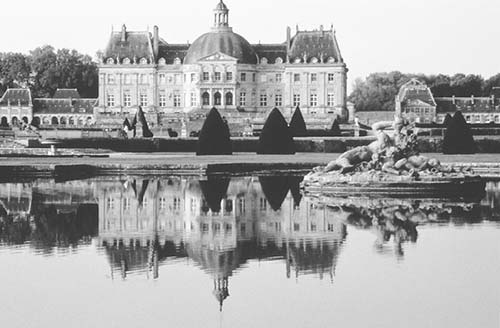
One of them was Nicolas Fouquet, France’s finance minister during the reign of Louis XIV, in the 17th century. Vaux-le-Vicomte was his home. A brilliant collaboration between three masters—architect Louis Le Vau, artist Charles Le Brun, and landscape designer André Le Nôtre (who pioneered the French formal garden)—this château was the architectural inspiration for Versailles and set the standard for European palaces to come. In fact, after several visits to the château during its construction, a very young Louis XIV found himself impressed that one man could create such magnificence. He was also curious how one man (other than himself) could pay for it. So Louis had the overly ambitious Fouquet arrested, hired his talented trio, and proceeded to have his bigger and costlier (but not necessarily more splendid) palace of Versailles built.
Monsieur Fouquet’s arrest features prominently in the third Musketeer book by Alexandre Dumas (and at least two versions of The Man in the Iron Mask were filmed here). From the prison cell where he died, Fouquet wrote longingly of his lost home, “This was the estate I regarded as my principal seat and where I intended to leave some traces of the status I had enjoyed.”
If the château feels a bit quirky in the way it’s run today, remember it’s not national property. It’s private. The château has been in the same family for five generations and was opened to the public in 1968 by Patrice de Vogüé, who still lives on the grounds (but not in the château).
Start your tour in the stables, at the fine Museum of Carriages (Musée des Equipages), where you can gallop through two long halls lined with elegant carriages from a time when horses were a big part of daily life. The exhibit begins with a reminder that when the château was built, France had 2.5 million horses (more than 100 horses per thousand people). Today France has 300,000 horses (just 5 per thousand people). While these stables are worth a look, there is no English info other than the entrance and exit signs.
Next, stroll like a wide-eyed peasant across the stone bridge that spans the ornamental moat facing the palace. Take some time to survey the grand design and admire the symmetry and elegance of the grounds, the outbuildings, and the palace itself. The gardens stretch far beyond the palace, but their main axis runs straight through the center of the château.
Next, enter the palace and pick up an audioguide if you want to rent one. As you wander through Fouquet’s dream home, you’ll understand Louis XIV’s envy. Versailles was a simple hunting lodge when this was built. Most of the paintings and furniture you’ll see here are not original—Louis confiscated what he liked for Versailles.
The one-way route first takes you through lavish rooms, then upstairs to a simple attic for an exhibition on carpentry and a peek at the wood structure of the building. From here, climb 80 steps between the inner and outer domes (claustrophobic for some) to a small terrace at the very top, where you can look out to the magnificent gardens—the first French formal gardens.
Continue through the last rooms on the tour route (these are among the best and are explained with concise little histories on the walls), and make your way to the palace’s back steps to survey André Le Nôtre’s first claim to fame. This garden was the cutting edge of sculpted French gardens. The designer integrated ponds, shrubbery, and trees in a style that would be copied in palaces all over Europe. Consider the 30-minute walk (one-way) to the viewpoint atop the grassy hill far in the distance. Rentable golf carts are worth the fee to make the trip easier (€15/45 minutes, 4 passengers maximum, ID and deposit required).
When it comes to showing the sweep of French history, the Château of Fontainebleau is unrivaled among French palaces. But don’t expect Versailles-like unity here. It’s a gangly and confusing series of wings that has grown with centuries of kings.
Its core was built by François I in 1528 over medieval foundations. While Vaux-le-Vicomte and Versailles are French-designed, Fontainebleau was built a century earlier by an Italian. Inspired by his travels through Renaissance Italy, François I hired Italian artists to build his palaces. He even encouraged one artist—Leonardo da Vinci—to abandon his native Italy and settle in France for the last three years of his life.
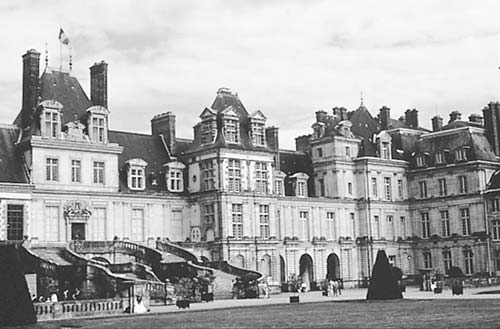
It seems every king, queen, and emperor since has loved this place—Louis XIII was born here, Louis XV married here, and Napoleon III was baptized here. And many years later, General George Patton set up headquarters here on his way to Berlin.
Above all, Fontainebleau has more Napoleon Bonaparte connections than any other palace in France. It was here that the pope met Napoleon before the general’s 1804 coronation as emperor. And it was from the château’s famous horseshoe-shaped staircase that Napoleon gave his stirring abdication speech, trading his rule of France for exile to Elba in 1814.
Tourist Information: There’s a small TI at the bus station (on the back side of the train station; follow signs for gare routiere). The town of Fontainebleau’s larger, helpful TI is two blocks across from the château, just behind Hôtel Londres. It has hiking and biking maps, information on where to rent bikes fit for the forest trails, and posted train/bus schedules (Mon-Sat 10:00-18:00, Sun 10:00-13:00 & 14:00-17:30, Nov-April closed Sun afternoon, 4 Rue Royale, tel. 01 60 74 99 99, www.fontainebleau-tourisme.com).
By Train: For a day trip to Fontainebleau, it’s best to purchase a Mobilis ticket—see details at the start of this chapter.
From Gare de Lyon, catch a train to Fontainebleau-Avon Station (nearly hourly, 45 minutes, direction: Montereau or Montargis). Trains leave from the Grandes Lignes tracks, typically in Hall 1, but finding the right train can be tricky in huge Gare de Lyon. Check return times before leaving Paris, as there can be big gaps.
From the Fontainebleau-Avon Station, take a bus or taxi to reach the château. Bus line 1 (direction: Les Lilas/Château) leaves from the bus stall marked #1-Château and makes the 20-minute trip to the Château stop at a snail’s pace (3/hour, €2 if purchased on board, Paris Métro tickets valid, included with Mobilis ticket—validate onboard). To return to the station, board bus #1 (direction: Les Bouleaux/Butte Montceau). The station stop is right in front of the station; confirm when you board the bus by asking, “Ce bus va à la gare?” (seh bews vah ah lah gar?).
Taxis from the train station to the château cost about €7 and are worth the convenience (more on Sun and after 19:00, taxi tel. 01 64 22 00 06).
By Car: Follow signs to Centre, then Château. Park across from the château in the big lot (Parking Boufflers) next to the Hôtel Londres. To reach Vaux-le-Vicomte from Fontainebleau (about 20 minutes), follow signs to Melun.
Cost: €11, free for those 17 and under, free first Sun of the month, €7 last hour of the day, covered by Paris Museum Pass.
Hours: Wed-Mon 9:30-18:00, Oct-March until 17:00, closed Tue year-round, last entry 45 minutes before closing, tel. 01 60 71 50 70, www.musee-chateau-fontainebleau.fr. Ballroom often closes one hour before château, and the Papal Apartment is sometimes closed 11:30-2:30.
Tours: The worthwhile videoguide costs €3.
Services: Pay lockers are available to store your bags.
The château’s complex floor plan can seem overwhelming, but visitors have little choice when touring the place, so don’t struggle to understand the overall design. Find the entry (inside the main gate on the right), and follow the one-way route through the Napoleon I Museum, special exhibit, and royal apartments.
The Napoleon I Museum is fascinating. The first room features grand portraits of Emperor Napoleon and his first wife, Empress Josephine (painted by Gérard after their coronation). Other rooms—each drenched in the Empire style—are dedicated to Napoleon at war (with his battle coat, tent, and camp gear); his second wife, Empress Marie Louise (whom he married for her Habsburg heritage, which Napoleon hoped would color his Corsican blood blue); and to their son, the “King of Rome,” Napoleon II (who lived in exile after his dad’s defeat and died of tuberculosis at 21).
The hallway is lined with busts and portraits of the sprawling imperial family Napoleon created—relatives he put on various thrones across his empire. Looking at the final painting, which depicts Napoleon with symbols of the legal system he gave France, the “Code Napoléon,” it’s fascinating to consider the mix of idealism, charisma, and megalomania of this leader. This revolutionary hero came out of a movement that killed off the Old Regime—only to create a new Old Regime.
After a swing through the portrait gallery, you’ll enter the royal apartments. The highlights are many. The Papal Apartment was renovated by Napoleon to house Pope Pius VII. The stunning Renaissance hall of François I, which dates from 1528, inspired other royal galleries, including the Hall of Mirrors at Versailles. The opulent ballroom (salle de bal) comes with piped-in music and has garden views that evoke royal fêtes. Napoleon’s throne room is the only French salle du trône that survives with its original furniture. You’ll also see the emperor’s bathroom, bed, and very important-looking desk.
The palace is slathered in royal and imperial symbolism, and its walls are hung with exquisite tapestries. As you walk its halls, track the artistic shift in style, from Renaissance to Rococo—whose whimsy infuriated the revolutionary mobs—to the more sober, postrevolutionary Neoclassical.
After touring the palace, the gardens—designed in the 17th century by landscape architect André Le Nôtre—are worth a stroll.
The town itself has a helpful TI (described earlier), a few hotels, and lots of eating options. The English bookstore ReelBooks, at 9 Rue de Ferrare, has a good collection of new, used, and children’s books. If you stop in, say hi to Sue and Judy (Tue-Sat 11:00-19:00, open some Sun, closed Mon, tel. 01 64 22 85 85).
Sleeping: $$ Hôtel de Londres*** is run by avid golfer Philippe, who rents 16 immaculate rooms, some with views of the château and most with air-conditioning. He also loans out free golf clubs—one of France’s most famous golf courses is close by (some view rooms, no elevator, 1 Place du Général de Gaulle, tel. 01 64 22 20 21, www.hoteldelondres.com, hdelondres1850@aol.com).
$$ Hôtel Ibis Château de Fontainebleau,** a five-minute walk from the château, is central, clean, and easy (18 Rue Ferrare, tel. 01 64 23 45 25, www.ibishotel.com, h1028@accor.com).
Eating: Scads of eating options are in the town center. To reach the center, turn right out of the château courtyard and walk down Rue Denecourt. An appealing collection of pedestrian lanes begins after Place Napoléon Bonaparte. Rue Montebello is restaurant row; you’ll find quieter places along the lanes off Rue de la Corne.
$$ La Taverne is a young, happening brasserie with good prices and nonstop service from 6:30 until late at night (daily, 23 Rue Grande, tel. 01 64 22 20 85).
$$ Le Bistrot delivers traditional cooking in a cozy atmosphere with a loyal local clientele (9 Rue Montebello, tel. 01 64 22 87 84).
$$ Le Grand Café, just across from the Chateau entrance, serves good brasserie fare (open daily, 33 Place Napoléon Bonaparte, tel. 01 64 22 20 32).
Chantilly (shahn-tee-yee), 30 minutes north of Paris, floats serenely on a reflecting pond. This extravagant hunting palace delivers great art and formal French gardens with an elaborate moat, but you won’t get a feel for château life here. The rooms are 19th-century recreations and can be visited only on a boring tour—in French.
Tourist Information: The TI is located in the linear town of Chantilly, about a half-mile to the left as you exit the train station (halfway between the station and the château). To reach the TI, walk straight out of the station and turn left on busy Avenue Maréchal Joffre, then turn right on Rue du Connétable (Mon-Sat 9:30-12:30 & 13:30-17:30, Sun 10:00-13:00 & 14:30-17:00, closed Tue afternoon May-Sept, 73 Rue du Connétable, tel. 03 44 67 37 37, www.chantilly-tourisme.com).
Taking a train to Chantilly is a breeze, but the last mile-and-a-half to the château is a headache unless you spring for a cab or enjoy a good walk. Leave from Paris’ Gare du Nord for Chantilly-Gouvieux (on the Creil line, Grandes Lignes). The RER serves Chantilly, but service is twice as fast on the Grandes Lignes main lines. Ask at any information desk for the next departure (hourly, fewer on weekends, 25 minutes by train, 50 minutes by RER, about €10 one-way). Upon arrival in Chantilly, confirm return times and whether the trip is via the faster train or slower RER.
Getting from the Station to the Château: It’s a level, 30-minute walk to the château through the woods and across a grassy park (maps posted on the exterior of the train station and around town). Walk straight out of the train station and cross the big road that separates the town from the woods. From here, several trails fan out in front of you. All lead to the château, but the most efficient and scenic route is the middle path, marked Le Tour de l’Hippodrome. (Midway to the château, a path leads to the left, where you can pop into town and visit the TI en route.) Walking back to the station, cross the big roundabout above the château, find wooden signs marked Gare, and follow them along a dirt path (passing behind the racetrack).
Otherwise, the easiest station-to-château trip is by taxi. Cabbies prefer longer fares, but they will take you to the château if they’re available. Taxi One is one of several options (about €9 one-way, €18 round-trip, mobile 06 42 05 46 79). The free city bus (called DUC, Desserte Urbaine Cantilienne) runs from the station to the château but is essentially useless (infrequent, not timed with train arrivals, none on Sun). Returning to the station, taxis and the city bus will pick you up at the château gate.
Cost: The château, gardens, horse museum, stables, and dressage horse demonstration are all covered by the Domaine ticket (€17, €9.50 for those under 18) or the Paris Museum Pass. To visit only the gardens, buy the Grounds ticket (€8). Horse enthusiasts can skip the château and buy a ticket that includes the horse museum, stables, dressage demonstration, and the fancier horse show (€21, see below).
Hours: April-Oct daily 10:00-18:00, Nov-March Wed-Mon 10:30-17:00, closed Tue.
Information: Tel. 03 44 27 31 80, www.domainedechantilly.com.
Tours: The free audioguide is worth picking up.
Horse Shows: At the horse museum, the 11:00 daily demonstration of dressage is included in your Domaine ticket. If you’re into horses dancing to music and riders in frilly dresses, spring for the show, which takes place daily at 14:30 April-Nov (adds €13 to the Domaine ticket; can also be purchased separately). Confirm demonstration and show times prior to your visit (same contact information as the château).
Lacking the well-preserved and grandiose interiors of other châteaux, Chantilly lays its claim to fame (and the main reason to visit) with its art collection. Because of the social upheaval in France during the Revolution of 1848, the château’s owner, Prince de Condé, fled to England. Twenty years later, when blue blood was safe again in France, he returned to his château with a fabulous collection of art (800 paintings, including three Raphaels) and priceless books. He turned his palace into the museum you see today and willed it to France on the condition that it would be maintained as he left it and the collections would never be loaned to any other museum.
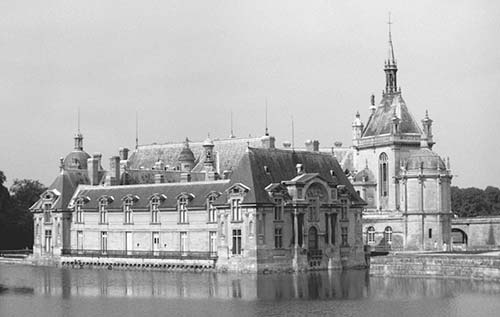
As most of the château was destroyed during the French Revolution, today’s palace is largely rebuilt in a fanciful 19th-century style. It’s divided into three parts: apartments, art gallery, and library. The apartments are partially open to the public; to visit the smaller private apartments, you need to pay a €3 supplement and either join a more frequent French-language tour or time your visit for the daily English tour at 15:00.
The art gallery and library are the stars (and are included with your entry). Wander the various rooms of the gallery using handheld explanations provided in each room (hunt for an English version). The audioguide adds meaning and context to your visit. Gallery highlights are paintings by Raphael, Titian, Nicolas Poussin, and Eugène Delacroix. Of the 13,000 books in the prince’s library, the most exquisite is the 40-page Book of Hours by Jean Fouquet (c. 1460).
The gardens immediately behind the château are geometric and austere. Drop down the steps from the château, turn right, and follow the signs for 10 minutes to le Hameau, where you’ll find a sweet little garden café (limited menu features desserts served with real Chantilly cream, open April-Oct). This little hamlet of three half-timbered, thatched-roofed homes was the prototype for the more famous hameau at Versailles. While the homes are peasant-simple on the outside, they are lavishly decorated within: The prince had certain needs when he played peasant. In summer, a shuttle bus occasionally circulates through the gardens (€5, leaves from entry gate).
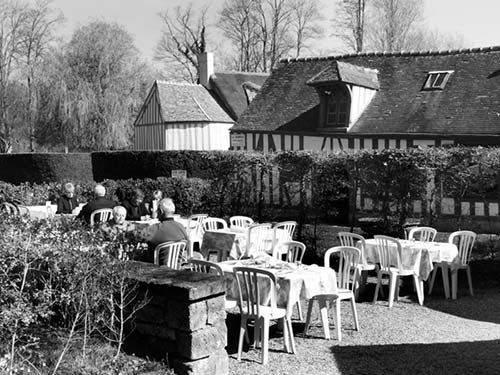
The prince believed he’d be reincarnated as a horse, so he built an opulent horse château—now a museum (it’s the huge building to the right as you look out from the château—allow 10 minutes to walk there from the château). The horse museum boasts 15 rooms displaying different bits of horse-related history and art. The museum is beautifully done, with explanations and videos, carved wooden horses from carousels, paintings, and examples of gear used when riding. Entry to the horse museum also includes a walk through the stables, with real-live horses and a demonstration of dressage (daily at 11:00, in French only with an English handout). To get the most from a visit, plan your time to see this demonstration.
You’ll find many cafés and restaurants in Chantilly town. A lively outdoor market runs on Saturday and Wednesday mornings until 12:30 on Place Omer Vallon. Otherwise, a café and a small bakery with sandwiches and drinks are across from the train station.